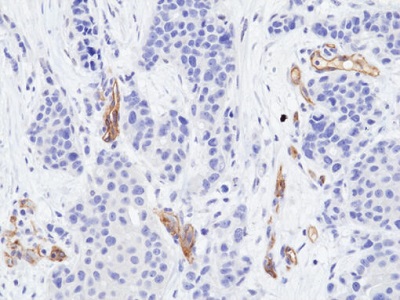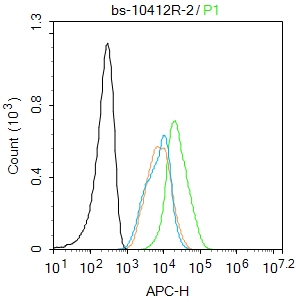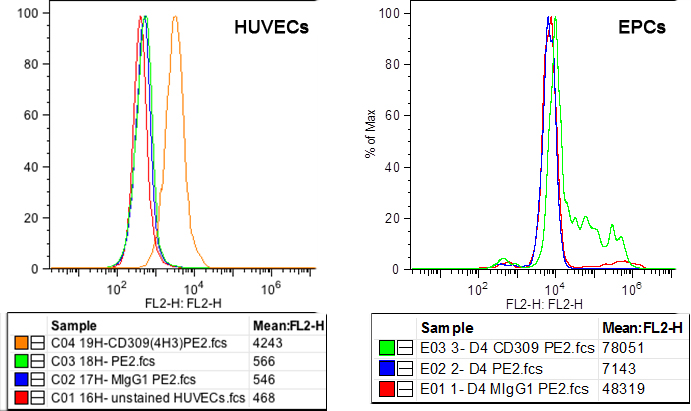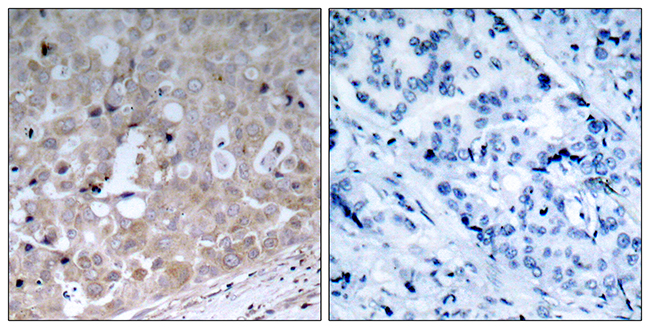
Immunohistochemical staining of formalin-fixed and paraffin-embedded human breast cancer tissue sections using anti-VEGFR2 Rabbit Monoclonal Antibody (Clone RM515) at 1:100 dilution for 1 hr at room temperature.
anti-VEGFR2 (human), Rabbit Monoclonal (RM515)
REV-31-1407-00
ApplicationsWestern Blot, ImmunoHistoChemistry
Product group Antibodies
TargetKDR
Overview
- SupplierRevMAb Biosciences
- Product Nameanti-VEGFR2 (human), Rabbit Monoclonal (RM515)
- Delivery Days Customer10
- ApplicationsWestern Blot, ImmunoHistoChemistry
- CertificationResearch Use Only
- ClonalityMonoclonal
- Clone IDRM515
- Gene ID3791
- Target nameKDR
- Target descriptionkinase insert domain receptor
- Target synonymsCD309, FLK1, VEGFR, VEGFR2, vascular endothelial growth factor receptor 2, fetal liver kinase-1, kinase insert domain receptor (a type III receptor tyrosine kinase), protein-tyrosine kinase receptor Flk-1, soluble VEGFR2, tyrosine kinase growth factor receptor
- HostRabbit
- IsotypeIgG
- Protein IDP35968
- Protein NameVascular endothelial growth factor receptor 2
- Scientific DescriptionDisruption of the precise balance of positive and negative molecular regulators of blood and lymphatic vessel growth can lead to myriad diseases. Although dozens of natural inhibitors of hemangiogenesis have been identified, an endogenous selective inhibitor of lymphatic vessel growth has not been previously described. A splice variant of the gene encoding vascular endothelial growth factor receptor-2 (VEGFR-2) that encodes a secreted form of the protein, designated endogenous soluble VEGFR-2 (esVEGFR-2/KDR) has been described. The endogenous soluble esKDR inhibits developmental and reparative lymphangiogenesis by blocking VEGF-C function. Tissue-specific loss of esKDR in mice induced, at birth, spontaneous lymphatic invasion of the normally alymphatic cornea and hyperplasia of skin lymphatics without affecting blood vasculature. Administration of esKDR inhibited lymphangiogenesis but not hemangiogenesis induced by corneal suture injury or transplantation, enhanced corneal allograft survival and suppressed lymphangioma cellular proliferation. Naturally occurring esKDR thus acts as a molecular uncoupler of blood and lymphatic vessels; modulation of esKDR might have therapeutic effects in treating lymphatic vascular malformations, transplantation rejection and, potentially, tumor lymphangiogenesis and lymphedema. - Recombinant Antibody. This antibody reacts to human VEGFR2 (KDR; FLK-1; CD309). Isotype: Rabbit IgG. Immunogen: A peptide corresponding to residues near the C-terminus of human VEGFR2. Applications: IHC, WB. Disruption of the precise balance of positive and negative molecular regulators of blood and lymphatic vessel growth can lead to myriad diseases. Although dozens of natural inhibitors of hemangiogenesis have been identified, an endogenous selective inhibitor of lymphatic vessel growth has not been previously described. A splice variant of the gene encoding vascular endothelial growth factor receptor-2 (VEGFR-2) that encodes a secreted form of the protein, designated endogenous soluble VEGFR-2 (esVEGFR-2/KDR) has been described. The endogenous soluble esKDR inhibits developmental and reparative lymphangiogenesis by blocking VEGF-C function. Tissue-specific loss of esKDR in mice induced, at birth, spontaneous lymphatic invasion of the normally alymphatic cornea and hyperplasia of skin lymphatics without affecting blood vasculature. Administration of esKDR inhibited lymphangiogenesis but not hemangiogenesis induced by corneal suture injury or transplantation, enhanced corneal allograft survival and suppressed lymphangioma cellular proliferation. Naturally occurring esKDR thus acts as a molecular uncoupler of blood and lymphatic vessels; modulation of esKDR might have therapeutic effects in treating lymphatic vascular malformations, transplantation rejection and, potentially, tumor lymphangiogenesis and lymphedema.
- Storage Instruction-20°C
- UNSPSC12352203






